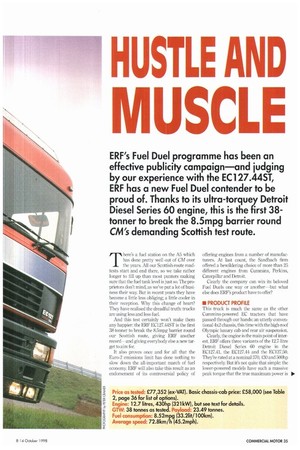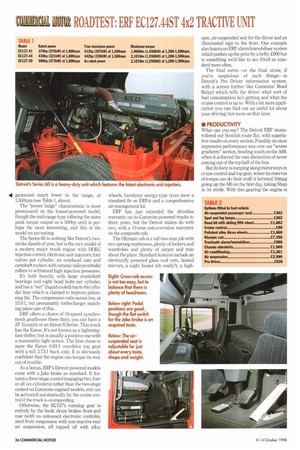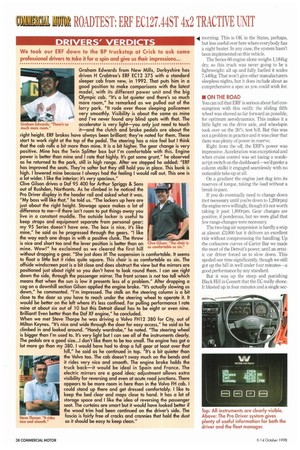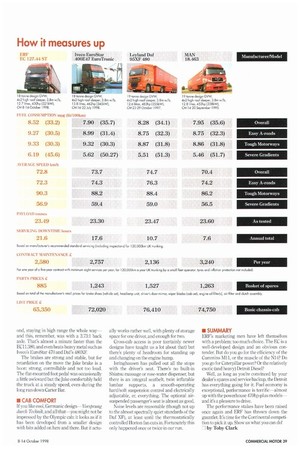HUSTLE AND
Page 37

Page 38

Page 39

Page 40

Page 41

If you've noticed an error in this article please click here to report it so we can fix it.
111111SCI.
ERF's Fuel Duel programme has been an effective publicity campaign—and judging by our experience with the EC127.44ST, ERF has a new Fuel Duel contender to be proud of. Thanks to its ultra-torquey Detroit Diesel Series 60 engine, this is the first 38tonner to break the 8.5mpg barrier round CM'S demanding Scottish test route.
There's a fuel station on the AS which has clone pretty well out of CM over the years. All our Scottish-route roadtests start and end there, so we take rather longer to fill up than most punters making sure that the fuel tank level is just so. The proprietors don't mind, as we've put a lot of business their way. But in recent years they have become a little less obliging; a little cooler in their reception. Why this change of heart? They have realised the dreadful truth: trucks are using less and less fuel.
And this test certainly won't make them any happier: the ERE EC127.44ST is the first 38-tonner to break the 8.5mpg barrier round our Scottish route, giving ERF another recordand giving everybody else a new target to aim for.
It also proves once and for all that the Euro-2 emissions limit has done nothing to slow down the all-important march of fuel economy. ERE will also take this result as an endorsement of its controversial policy of offering engines from a number of manufacturers. At last count, the Sanclbaell firm offered a bewildering choice of more than 25 different engines from Cummins, Perkins, Caterpillar and Detroit.
Clearly the company can win its beloved Fuel Duels one way or another—but what else does ERF's product have to offer?
• PRODUCT PROFILE This truck is much the same as the other Cummins-powered EC tractors that have passed through our hands: an utterly conventional 4x2 chassis, this time with the high-roof Olympic luxury cab and rear air suspension.
Clearly, the engine is the main point of interest. ERE offers three variants of the 12.7-litre Detroit Diesel Series 60 engine in the EC127.41, the EC127.44 and the EC127.50. They're rated at a nominal 370.430 and 500hp respectively. But it's not quite that simple: the lower-powered models have such a massive peak torque that the true maximum power is 41 generated much lower in the range, at 1,500rpm (see Table 1, above).
The "power bulge" characteristic is most pronounced on the lowest-powered model, though the mid-range type (offering the same peak torque output as a 500hp unit) is perhaps the most interesting, and this is the model we are testing.
The Series 60 is nothing like Detroit's twostroke diesels of yore, but is the very model of a modern major truck engine with DDEC injection control; electronic unit injectors; four valves per cylinder; an overhead cam and camshaft rockers with ceramic (silicon nitride) rollers to withstand high injection pressures.
It's built heavily, with large crankshaft bearings and eight head bolts per cylinder, and has a "wet" (liquid-cooled) top to the cylinder liner which is claimed to improve pistonring life. The compression ratio seems low, at 15.0:1, but presumably turbocharger matching takes care of this ERF offers a choice of 16-speed synchromesh gearboxes these days; you can have a 2F Ecosplit or an Eaton S-Series. This truck has the Eaton. It's not known as a lightningfast shifter, but is usually a positive one with a reasonably light action. The firm chose to mate the Eaton 0.83:1 overdrive top gear with a tali 3.73:1 back axle. It is obviously confident that the engine can torque its way out of trouble.
As a bonus, ERF's Detroit-powered models come with a Jake brake as standard. It features a three-stage control (engaging two, four or all six cylinders) rather than the two-stage control on Cummins-engined models, and can be activated automatically by the cruise control if the truck is overspeeding.
Otherwise, the EC127's running gear is entirely by the book: drum brakes front and rear (with no untoward electronic controls), steel front suspension with non-reactive rear air suspension, all topped off with alloy wheels, Goodyear energy.type tyres (now a standard fit on ERFs) and a comprehensive air-management kit.
ERF has just extended the driveline warranty on its Cummins-powered trucks to three years, but the Detroit makes do with two, with a 10-year anti-corrosion warranty on the composite cab.
The Olympic cab is a tall two-man job with two sprung mattresses, plenty of lockers and wardrobes and plenty of carpet and trim about the place. Standard features include an electrically powered glass roof vent, heated mirrors, a night heater (oh really?), a high spec, air-suspended seat for the driver and an illuminated sign to the front. Our example also boasts an ERF alarm/immobiliser system which pushes up the price by a hefty £900 but is something we'd like to see fitted as standard more often.
The final extra—or the final straw, if you're suspicious of such things—is Detroit's Pro Driver information system, with a screen (rather like Cummins' Road Relay) which tells the driver what sort of fuel consumption he's getting and what the cruise control is up to. With a bit more application you can find out an awful lot about your driving; but more on that later.
• PRODUCTMTY
What can you say? The Detroit ERF steamrollered our Scottish route flat, with superlafive results on every section. Possibly its most impressive performance was over our "severe gradients" section, heading south on the A68, when it achieved the rare distinction of never coming out of the top half of the box.
But its forte is romping along motorways in cruise control and top gear, where its reserves of torque can do their stuff: it bettered lOmpg going up the M6 on the first day, taking Shap in its stride. With this gearing the engine is operating most efficiently at its limited speed in top. In fact, a study of Pro Driver at the end of the trip revealed that the truck had spent 69% of its time in top, averaging 10.63mpg as it did so. This, remember, is at a full 38 tonnes.
And the ERF wasn't dawdling: it possesses superb acceleration, both from a standing start (0-50mph in 45.5sec) and in the intermediate gears. The response isn't quite like lightning-it's too big an engine for that-but it's always there for you.
Pro Driver can also tell you how long the engine has spent idling; how the PTO has been used; maximum speed and engine speed events; and when servicing or oil changes are required. It also in command of what Detroit calls "Optimised Idle". This system senses if the engine has been idling excessively and turns the engine off (until the driver says so), or turns it on if a warm start is needed in the 110.
.41 morning. This is OK in the States, perhaps, but less useful over here where everybody has a night heater. In any case, the system hasn't been implemented on this vehicle.
The Series 60 engine alone weighs 1,184kg dry, so this truck was never going to be a lightweight: all up and fully fuelled it scales 7,440kg. That won't give other manufacturers sleepless nights, but it does include about as comprehensive a spec as you could wish for.
• ON THE ROAD You can tell that ERF is serious about fuel consumption with this outfit: the sliding fifth wheel was shoved as far forward as possible, for optimum aerodynamics. This makes it a little light on the drive axle, and wheelspin took over on the 20% test hill. But this was not a problem in practice and it was clear that there was plenty of power in reserve.
Right from the off, the ERF's power was impressive. Acceleration was exceptional and when cruise control was set (using a nondescript switch on the dashboard—we'd prefer a column stalk) it engaged seamlessly with no noticeable take-up at all.
On a gradient the engine just dug into its reserves of torque, taking the load without a break in pace.
If you do eventually need to change down (not necessary until you're down to 1,200rpm) the engine revs willingly, though it's not worth taking it past 1,800rpm. Gear changes are positive, if ponderous, but we were glad that few range-changes were necessary.
The two-bag air suspension is hardly a snip at almost .£3,000 but it delivers an excellent ride without compromising the handling. Up the corkscrew curves of Carter Bar we made the most of the Detroit's power, until an erratic car driver forced us to slow down. This spoiled our time significantly, though we still got up the hill in well under four minutes—a good performance by any standard.
But it was up the steep and punishing Black Hill in Consett that the EC really shone. It blasted up in four minutes and a single sec
ond, staying in high range the whole wayand this, remember, was with a 3.73:1 back axle. That's almost a minute faster than the K11.380. and even beats heavy metal such as Iveco's EuroStar 470 and Daf's 480XF.
The brakes are strong and stable, but for retardation on the move the Jake brake is a boon: strong, controllable and not too loud. The fiat-mounted foot pedal was occasionally a little awkward but the Jake comfortably held the truck at a steady speed, even during the long run down Carter Bar.
• CAB COMFORT If you like cool, Germanic designVorsprung durch Technik, and all that-you might not be impressed by the Olympic cab: it looks as if it has been developed from a smaller design with bits added on here and there. But it actu
ally works rather well, with plenty of storage space for one driver, and enough for two.
Cross-cab access is poor (certainly newer designs have taught us a lot about that) but there's plenty of headroom for standing up and changing on the engine hump.
Isringhausen has pulled out all the stops with the driver's seat. There's no built-in Shiatsu massage or rose-water dispenser, but there is an integral seatbelt, twin inflatable lumbar supports, a smooth-operating hard/soft suspension control and electrically adjustable, er, everything. The optional airsuspended passenger's seat is almost as good.
Noise levels are reasonable (though not up to the almost spectrally quiet standards of the Daf XF), at least until the thermostatically controlled IIorton fan cuts in. Fortunately this only happened once or twice in our run. • SUMMARY ERF's marketing men have left themselves with a problem: too much choice. The EC is a well-developed design and an obvious contender. But do you go for the efficiency of the Cummins M11, or the muscle of the N14? Do you go for Caterpillar power? Or the relatively exotic (and heavy) Detroit Diesel?
Well, as long as you're convinced by your dealer's spares and service backup, the Detroit has everything going for it. Fuel economy is exceptional, performance is terrific-almost up with the powerhouse 470hp-plus modelsand it's a pleasure to drive.
The performance stakes have been raised once again and ERF has thrown down the gauntlet. It's time for the Continental competition to pick it up. Show us what you can do!
71 by Toby Clark
Price as tested: £77,352 (ex-VAT). Basic chassis-cab price: £58,000 (see Table 2, page 36 For list of options).
Engine: 12.7 litres, 430hp (321kWh but see text for details.
• G1W: 38 tonnes as tested. Payload: 23.49 tonnes. Fuel consumption: 8.52mpg (33.214/100km). Average speed: 72.8km/b (45.2mph). TABLE 2
Options fitted to test vehicle Air-suspended passenger seat £302 Spot and log lamps £262 Road kit with sliding fifth wheel £1,802 Cruise control £90 Polished alloy Alcoa wheels. £1,860 Olympic cab £7,350 Trucksafe alarm/immobiliser £900 Chassis sideskirts £1,909 Air conditioning £1,261 Air suspension £2,990 Pro Driver £626
SPECIFICATION
MEM ERE EC127_445T.
Design GTW: 44,000kg. Design GYW: 38,000kg.
Plated GVW: 18,00014
Manufacturer: ERF, Sun Works, Cheshire CW11 30N.
IIIMMIM Detroit Diesel Series 60-440 Euro-2,
Cylinders: Six, in line. Bore/shake: 130x160mm.
(apacity: 12,7 litres.
Compression ratio: 15.0:1,
Maximum net powers 430hp1321kW)at 1,800rpm 'see text). Maximum net torque: 2,101r4m 11,550115k) between
1,200-1,500rpm.
Eaton S-Series (RTS0 17316A) 16-speed synchromesh gearbox with range change and splitter. Final drive: Mentor 5180 single-reduction rear axle with differential lock, Rollo: 3.73-.1
TRANSMISSION.
Optional ratios: 3 R1 and 4 10;1.
Clutch: A -assisied twin ceramic dry plate
Dual-circuit air-operated brakes incorporating load sensing and Cat I ABS; drums fitted front and rear.
Air reservoirs: 4x30111.
Periling: Spring chambers on both axles.
Brake dimensions: Front and rear, 410x200rnm.
Secondary braking: Jacobs engine brake Istandard on ERF Detrot models).
BRAKING SYSTEMS
RIM= ZF integral hydraulically assisted, recirculating ball.
MEM Pressed-steel channel (270x85x8mm) frame with riveted cross-members.
Suspension: Front, steel taper leaf springs with anti-roll bar and double-acting telescopic shock absorbers, rear, two-bag nonreactive air suspension. Axle design weights: Front, 7,100kg; rear, 11,500kg. Axle plated weights: Front, 7,100kg; rear, 1 0,500kg. Wheels and tyres: 8.25x22.5in Alcoa alloy wheels fitted with Goodyear 295/80 R22.5 tyres {front, G391Es; rear, G267Es1. Fuel tank: 400 litres.
MIEDESTEREE 241/ insulated double pole. Batteries: 2x1 2V/165Ah.
Alternator: 55A,
151=11MI 13.6m curtairsider running on three airsuspended axles.
Two years on whole vehicle; 10year cab warranty against corrosion. ERF Freeway roadside assistance/recovery for 12 months.
TERMS OF WARRANTY:
DEALERS AND SERVICE POINTS:
ERF has 20 distributors offering soles, parts and service, 24 dealers and 34 service repairers-o total network of 78 sites in the LIK.
OPERATIONAL TRIAL RESULTS
Scottish test route: 1,180km.
Day 1 (348km): Average speed, 81.3krn/1-1, fuel consumption, 9.58mpg {29 5Iii/ I DOkm),
Day 2 (402km): Average speed, 68.0km/h; fuel consumption, 8.25mpg (34.31R/100kml,
Day 3 (430km): Average speed, 71.5km/h; fuel consumption, 8.04mpg (35.11it/100km). Overall: Average speed, 72.8km/b; average fuel consumption, 8.52mp9 (33.21i1/1001sm).
N-CAB NOISE
km/h 48 dBIA)
64 66.0


























































































































